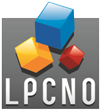Seminar Damien Baigl
ENS Paris
Reconfigurable self-assembly: evolutive DNA nanomachines, coffee-ring diagnostics and living crystals
Self-assembly is a both a formidable method to organize molecular or colloidal entities into functional superstructures and a playground for the scientific endeavor on how matter organizes itself. Self-assembly is also a key-feature of how life builds its components. However, compared to their living counterparts, synthetic materials made by self-assembly usually lack some of the characteristic properties of living systems such as reconfigurability, adaptability or evolution.
In this presentation, I will describe different systems where such properties can emerge from self-assembled synthetic materials. First, I will show that elaborate user-defined DNA nanostructures (e.g., DNA origamis, tiles, extended nanogrids) can be obtained by spontaneous self-assembly at room temperature for the first time with a unique capability to adapt to their environment by changing their shape, transforming and evolving [1,2]. Then, I will present a new DNA self-assembly principle that does not rely on base-pairing principles. I will show in particular that photosensitive DNA intercalating molecules can co-assemble with DNA bases to form new extended supramolecular materials of unprecedented properties. I will describe in particular the formation of photoswitchable 3D crystals with unique photoreversible growth and light-gated fluorescence [3].
Finally, I will present different colloidal self-assembly processes at air-water or liquid-liquid interfaces and explore how dynamic properties can emerge from such systems. Starting from the familiar situation of drying drop containing a colloidal suspensions, we have been interested in controlling/cancelling the so-called “coffee-ring effect” [4-7] or turning it into a low-cost yet powerful medical diagnostic tool [8]. In such systems, however, particles adsorb atthe interface to form amorphous structures. This led us to invent a simple method in which bulk particles adsorb at the water-interface and directly crystallize there. Based on the use of ultralow amounts of surfactant, 2D colloidal crystals spontaneously form without any other applied force than their own weight [9]. This method allows us to crystallize a broad variety of nanometric and micrometric particles, including those made of polymers, metals or inorganic materials, and tune the characteristics of the colloidal crystals [10]. These colloidal crystals display intense structural colors as well as, under some conditions, some remarkable dynamic properties at the air/water interface. For instance, using light, we can reversibly melt/crystallize these colloidal assemblies on command, evidencing interesting life-like properties, such as dissipative or living crystallization [11,12].
References
[1] Rossi-Gendron et al., ChemRxiv 2022 (preprint), doi : 10.26434/chemrxiv-2022-12jqs
[2] Nakazawa et al., Angew. Chem. Int. Ed.2021, 60, 15214 –15219
[3] Zhou et al., J. Am. Chem. Soc.2019, 141, 9321–9329
[4] Anyfantakis et al., Angew. Chem. Int. Ed.2014, 53, 14077–14081
[5] Varanakkottu et al., Nano Lett.2016, 16, 644–650
[6] Poulichet et al., J. Colloid. Interf. Sci.2020, 573, 370-375
[7] Galy et al., ACS Appl. Mater. Interfaces2022, 14, 3374–3384
[8] Devineau et al., J. Am. Chem. Soc. 2016, 138, 11623–11632
[9] Anyfantakis, Langmuir2018, 34, 15526−15536
[10] Vialetto et al., Nanoscale2020, 12, 6279-6284
[11] Vialetto et al. Angew. Chem. Int. Ed.2019, 58, 9145-9149
[12] Vialetto et al., J. Am. Chem. Soc.2021, 143, 11535−11543

